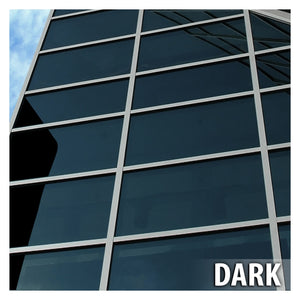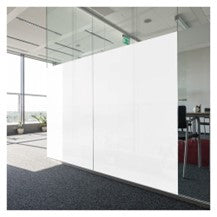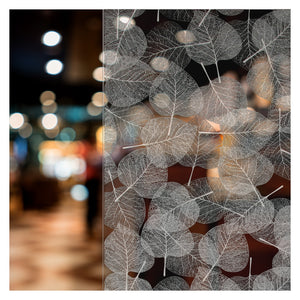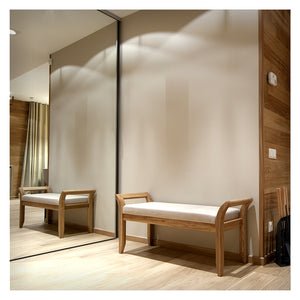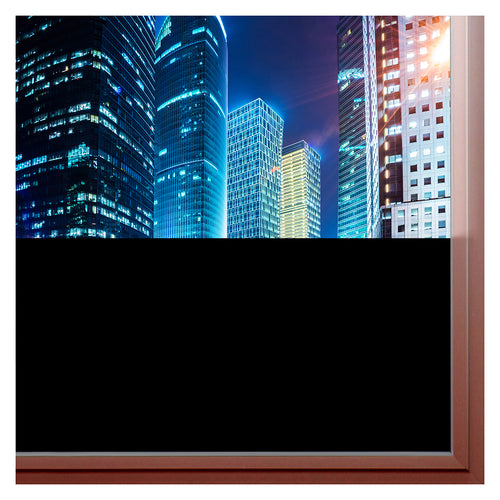Check out our Youtube video on how to install self-adhesive window film
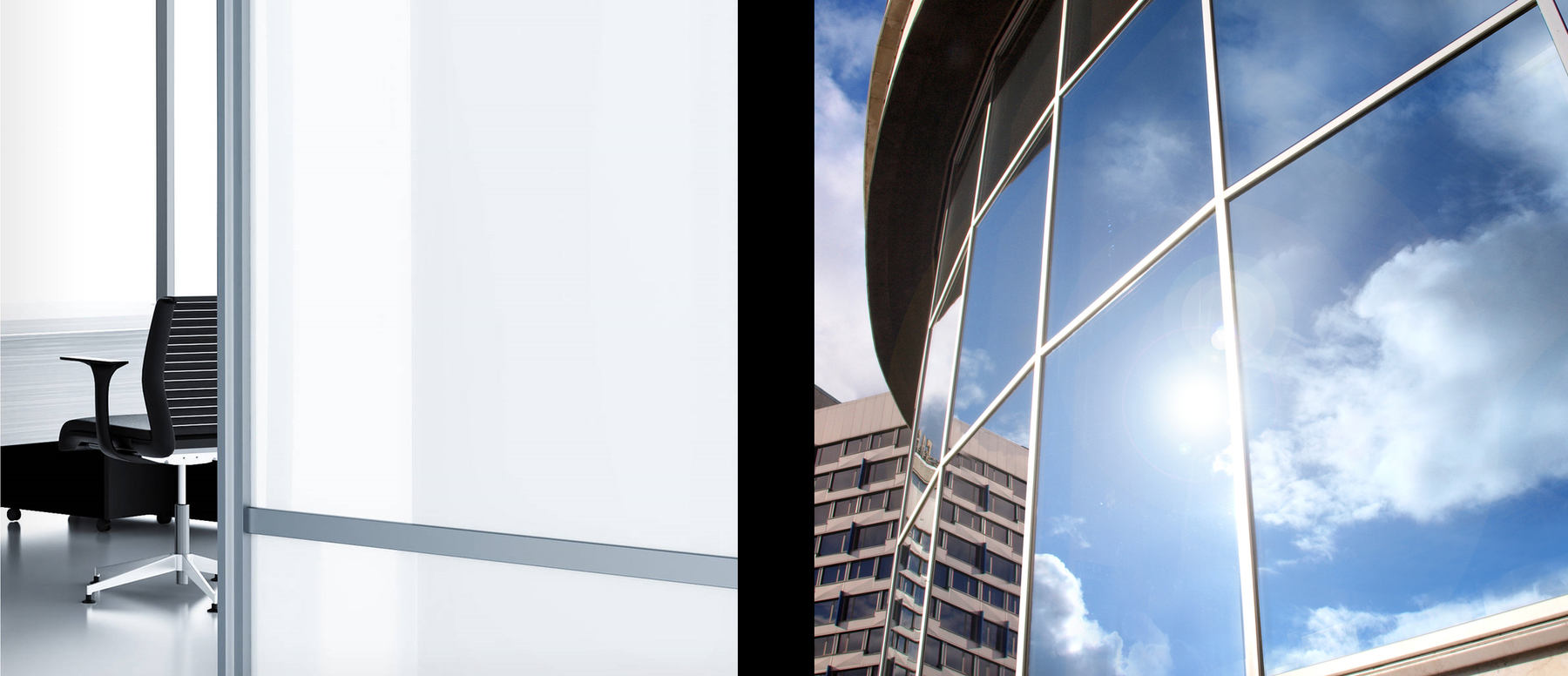
Types of Privacy Films
Types of Privacy Films
Privacy window films can be broadly divided into 24-hour privacy and daytime privacy. It can be helpful to understand the difference between these types to ensure that you purchase the correct film for your needs.
24-hour Privacy (Opaque) Films
The simplest way to prevent people from seeing through the window is to block out the view with an opaque layer, such as a curtain. Our opaque privacy films can be installed on windows to provide a similar effect.
What the film does: The opacity of this type of film prevents seeing through the window in either direction. These films are designed for 24-hour privacy, regardless of the lighting conditions on each side around the film.
Our most opaque films are the blackout films, which block virtually all light. Other films with high opacity block or blur the view so that people would not be able to tell what is on the other side, but these non-blackout films do let filtered light through; when objects are very close to the window, the film would show the silhouettes of those objects.
Where to use the film: Opaque films are useful for partitions inside the building. A 24-hour privacy film can be applied on glass walls, doors, or windows that are located between rooms or sections of the interior. This obscures the view from each side to the other, providing privacy and personal space.
Opaque films can also be used on windows that face the outside if you do not need to view out from those windows. You can also decide which parts should be hidden or shown: just apply the film to the areas where you would like to keep things private.
|
Opaque film on glass forming a partition
|
Opaque film on glass facing outside
|
Daytime Privacy Films
If you do not want people to look in from outside, but still want to have visibility of the outdoors from inside, daytime privacy films may be a good option. As the name suggests, these films will provide privacy only during the day.
How the film functions: This type of film depends greatly on the amount of light on each side around the film. These films have a degree of transparency, so if you hold up a piece of the film, normally you can see through it. But when one side has less light than the other, the darker side is concealed by the film and not seen from the other side. Meanwhile, the brighter side remains visible through the film from the opposite side.
How the film provides privacy: Once this film is installed on a window facing the outdoors, it results in a privacy effect during daytime. This is when the sun makes the outside much brighter, so the film prevents onlookers from looking in, while preserving the view of the outside. The tint causes the appearance of this view to be darker and more reflective than with a clear glass, depending on the film you use, but the ability to see out through the window from within is retained.
At night, however, if you have lights on inside the building, bystanders would be able to peek in from outside; conversely, the film would make it harder for you to see out at nighttime. Because the lighting inside would make the interior brighter than the outside, it would now be easier to see in through the window than to see out.
Where to use the film: It is important to remember that the film requires a difference in brightness between the two sides in order to only allow viewing in one direction. It is harder to achieve this difference in an interior partition, so ordinarily these films are installed on windows located between the outside and the building interior.
When you have lights on inside at night, it is recommended to have curtains or blinds closed over the window during nighttime to keep people from looking in. During the day, you can leave the curtains or blinds wide open to enjoy the view of the outdoors while still having privacy.
One way mirror: A one way mirror film is a window film that can be seen through in one direction, but looks like a mirror when seen in the other direction, when there is a difference in the amount of light. From the side with more light, observers will not see the darker side behind the film, only their own reflection. Observers from the side with less light, on the other hand, can see the brighter side (albeit with some reflection on the film).
Daytime privacy films with a dark silver tint can create this one way mirror effect. Mirror silver tints will have a mirror-like appearance on whichever side of the film with more light exposure. There are also films with silver color on one side of the film and a different color, which can have lower reflectivity than silver, on the other side.
|
Daytime privacy film, view from inside: clear (left), tinted (right)
|
|
Daytime privacy film, view from outside (daytime): clear (left), tinted (right)
|
|
Daytime privacy film, view from outside (nighttime): clear (left), tinted (right)
|
Summary and Comparison
- Opaque privacy films block the view from either side.
- Daytime privacy films conceal the side with less light from the other side, while allowing the brighter side to be seen through the film.
- During the day, daytime privacy films block the view from outside to inside, but allow the view from inside to outside, because the sunlight makes outside brighter. At night, the effect is reversed if lights are turned on inside.
|
Privacy Type |
Opaque (24-hour) |
Daytime Privacy |
|
Privacy and View |
Film blocks view from either side |
During daytime, film blocks view from outside while allowing you to see out from inside |
|
Applicable Time |
24-hour privacy |
Daytime privacy only; curtains or blinds recommended at night |
|
Recommended Use |
Recommended for partitions within the building, and other places where visibility through the window is not needed |
Recommended for windows that face the outside, where view of outside is desired during the day |
Common Issues and Questions
- The film has no privacy at night (the customer installed a daytime privacy film).
This film provides privacy only during daytime. At night, people can see in because the lighting makes the interior brighter than outside. To keep people from looking in at night, you should cover the window with curtains or blinds.
- I cannot see out from inside with this film on the window (the customer installed an opaque film).
This film prevents view from both sides. If you would like to see the outside while having privacy, you should use a daytime privacy film.
- The tint was applied to the window, but I can still see in from outside (the customer installed a film with a lighter tint).
This tint is not dark enough for privacy. A tinted window can reduce glare and block some heat, along with most of the UV rays, but only darker tints would produce reliable daytime privacy. With a lighter tint, enough light can pass through the tint to allow people to see past the film.
- I took out this film and I can see through it (the customer is looking at a portion of the film that has not yet been installed).
The privacy aspect is not intrinsic to the film; instead, it is an effect that occurs under correct conditions (how much light is present). Once one side is dark and the other bright, the dark side is kept private from the bright side by the film. If you can see through the film when you simply unroll a film portion and look at it, it is because an ample amount of light is about equally present on both sides.
- Is there a film that also provides privacy from outside at night?
Opaque films provide 24-hour privacy, but you would not be able to see, either.
The daytime privacy films have a trade-off: if you can see out during the day, people outside can look in at nighttime for the same reason. You can complement the window film with curtains or blinds, which would be closed at night to prevent people from looking into the bright interior. However, you cannot have a setup at night that simultaneously allows you to see out and keeps people from seeing in, because it is inherently easier to see the brighter side.
- What would be the purpose of a film that only has privacy during daytime?
Daytime privacy maintains the view of the outdoors. This type of film is ideal for locations that do not need any lighting at night, such as businesses that are only open during daytime, as these places would only require the benefit of privacy when the film is effective.
Curtains and blinds give you control over when the window view is opened or closed. A daytime privacy film can augment these window treatments: even when they are opened to enable you to see out, your private life would be shielded from outsiders.
- I purchased a one way mirror film, but both sides of the film have a reflective silver tint.
Some customers might interpret “one way mirror” to mean that only one side of the film has a mirror tint, but this is not necessarily the case. The term does not refer to the composition of the film itself; it means that the film gains the “one way mirror” function when one side is much brighter than the other. Under such conditions, the film would look mirrored from the brighter side, but it would be relatively transparent in the other direction.
- I installed a one way mirror film and I am seeing a reflection from inside. It seems that the reflection effect is in the wrong direction.
For the reason stated above, a dark silver color film can be considered a one way mirror film even with a silver tint on both sides. Such films do not have a predetermined direction with regards to which side is reflective. Rather, the reflectivity hinges on the amount of light. The silver tint causes the window to have some reflection on both sides, but the side exposed to more light will have a more reflective appearance.
Some films do have a silver tint on only one side, because the other side has another, less reflective tint. This may be preferable if you do not want the interior-facing side of the film to be too reflective. However, the principles of daytime privacy still apply to these dual color films.



